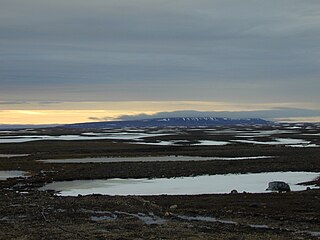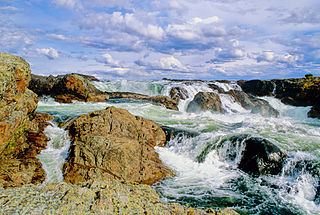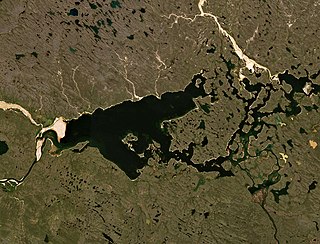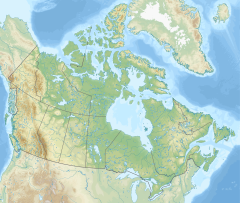
The Back River, formerly Back's River, is the 20th longest Canadian river and is located in the Northwest Territories and Nunavut. It rises at an unnamed lake in the North Slave Region of the Northwest Territories and flows more than 974 km (605 mi) mostly through the Kivalliq Region, Nunavut, to its mouth at the Arctic Ocean in the Kitikmeot Region of Nunavut.

Baffin Island, in the Canadian territory of Nunavut, is the largest island in Canada and the fifth-largest island in the world. Its area is 507,451 km2 (195,928 sq mi), slightly larger than Spain; its population was 13,039 as of the 2021 Canadian census; and it is located at 68°N70°W. It also contains the city of Iqaluit, the capital of Nunavut.

Victoria Island is a large island in the Arctic Archipelago that straddles the boundary between Nunavut and the Northwest Territories of Canada. It is the eighth-largest island in the world, and at 217,291 km2 (83,897 sq mi) in area, it is Canada's second-largest island. It is nearly double the size of Newfoundland (111,390 km2 [43,010 sq mi]), and is slightly larger than the island of Great Britain (209,331 km2 [80,823 sq mi]) but smaller than Honshu (225,800 km2 [87,200 sq mi]). The western third of the island lies in the Inuvik Region of the Northwest Territories; the remainder is part of Nunavut's Kitikmeot Region. The population of 2,168 is divided among 2 settlements, the larger of which is in Nunavut and the other of which is in the Northwest Territories.

Rankin Inlet is an Inuit hamlet on the Kudlulik Peninsula in Nunavut, Canada. It is the largest hamlet and second-largest settlement in Nunavut, after the territorial capital, Iqaluit. On the northwestern Hudson Bay, between Chesterfield Inlet and Arviat, it is the regional centre for the Kivalliq Region.

Cambridge Bay is a hamlet located on Victoria Island in the Kitikmeot Region of Nunavut, Canada. It is the largest settlement on Victoria Island. Cambridge Bay is named for Prince Adolphus, Duke of Cambridge, while the traditional Inuinnaqtun name for the area is Ikaluktutiak or Iqaluktuuttiaq meaning "good fishing place".

The Thelon River stretches 900 kilometres (560 mi) across northern Canada. Its source is Whitefish Lake in the Northwest Territories, and it flows east to Baker Lake in Nunavut. The Thelon ultimately drains into Hudson Bay at Chesterfield Inlet.

Tuktut Nogait National Park is a national park located in the Northwest Territories of Canada that was established in 1998. Meaning "young caribou" in Inuvialuktun, the park is home to the calving grounds of the Bluenose-West caribou herd.

Bathurst Inlet,, is a small Inuit community located in Bathurst Inlet in the Kitikmeot Region of Nunavut, Canada.

Ovayok Territorial Park is a park situated 15 km (9.3 mi) east of Cambridge Bay, in the Kitikmeot Region, Nunavut, Canada. The park is relatively small and covers an area of approximately 16 km2 (6.2 sq mi). The park can be accessed by vehicle from the community as a gravel road runs directly to it.

The Kazan River, is a Canadian Heritage River located in Nunavut, Canada. The Dene name for the river was Kasba-tue meaning "white partridge river." The name was apparently changed to Kazan in the late 19th century due to the influence of Order of Mary Immaculate missionaries. The river headwaters are in northern Saskatchewan at Kasba Lake, and it flows north for about 1000 km (621 mi) before emptying into Baker Lake, on the opposite side of the mouth of the Thelon River. Along its course the river flows through several lakes, including Ennadai Lake and Yathkyed Lake, over the Kazan Falls, down a red sandstone gorge and through both boreal forest and tundra. It is the last section of the river, below Ennadai Lake, that is above the timber line and is designated a Canadian Heritage River.

Caribou Inuit, barren-ground caribou hunters, are Inuit who live west of Hudson Bay in Kivalliq Region, Nunavut, between 61° and 65° N and 90° and 102° W in Northern Canada. They were originally named "Caribou Eskimo" by the Danish Fifth Thule Expedition of 1921–1924 led by Knud Rasmussen. Caribou Inuit are the southernmost subgroup of the Central Inuit.

Beverly Lake is a lake in the Kivalliq Region, Nunavut, Canada. It is located north of the Arctic tree line about 150 km (93 mi) northwest of Baker Lake, Nunavut. The western half of the lake is within Thelon Wildlife Sanctuary. The Thelon River, at the confluence with the Dubawnt River, empties into the lake's southwestern bank. The Kazan River empties into the Thelon River at Beverly Lake's southeastern bank, between Beverly and Aberdeen Lakes. A delta occurs on the Beverly Lake's southern edge, which includes the Isarurjuaq Peninsula.

Tahiryuaq, formerly Ferguson Lake, is located on southern Victoria Island in the Kitikmeot Region of Nunavut, in northern Canada. It drains westward into Iqaluktuuq which is a segment of the Ekalluk River, 8.0 km (5 mi) from the northeastern side of Wellington Bay (Ekaloktok), on Dease Strait, Arctic Ocean Ferguson Lake was the namesake of Constable Ferguson, a Royal Canadian Mounted Police member, but is now known by the original name of Tahiryuaq
Ferguson Lake is a lake in Kivalliq Region, Nunavut, Canada. It is located 150 km (93 mi) north of the tree line, midway between Yathkyed Lake and Qamanirjuaq Lake. The lake's outflow is to the east into the Ferguson River, which flows eastward through several lakes, emptying into northwestern Hudson Bay between Rankin Inlet and Whale Cove. The closest community is Baker Lake, 160 km (99 mi) to the north.

Garry Lake is a lake in sub-Arctic Kivalliq Region, Nunavut, Canada. As a portion of the Back River waterway, Garry Lake originates directly east of Lake Pelly and drains to the east by the Back River. A set of rapids separate Buliard Lake from Garry Lake. Two other sets of rapids separate Garry Lake's three sections which are also differentiated by elevation. Garry Lakes are isolated from nearby communities.

Copper Inuit, also known as Kitlinermiut and Inuinnait, are a Canadian Inuit group who live north of the tree line, in what is now the Kitikmeot Region of Nunavut and in the Inuvialuit Settlement Region in the Inuvik Region of the Northwest Territories. Most of them historically lived in the area around Coronation Gulf, on Victoria Island, and southern Banks Island.
Wellington Bay is an Arctic waterway in Kitikmeot Region, Nunavut, Canada. It is located in Dease Strait, off southern Victoria Island. It is northwest of the community of Cambridge Bay.
Tahiryuaq, formerly Tahiryuak Lake, is a lake located in the Canadian Arctic's Northwest Territories. It is situated in northcentral Victoria Island, north of Prince Albert Sound, southeast of Minto Inlet.

Sylvia Grinnell Territorial Park is a Canadian territorial park on Baffin Island in the province of Nunavut.
The Thlewiaza River is a river in Canada. Although some sources define the river as originating out of Nueltin Lake, according to the Canadian Geographical Names Database the river begins at Snyder Lake in northwestern Manitoba. From there the river flows northeast through Kasmere Lake into the southwest end of Nueltin Lake. It exits Nueltin Lake at its northern end in Nunavut and flows 275 kilometres (171 mi) east through Edehon Lake and Ranger Seal Lake before emptying into Hudson Bay. Its drainage basin covers an area of 64,399.6 square kilometres (24,864.8 sq mi).

















